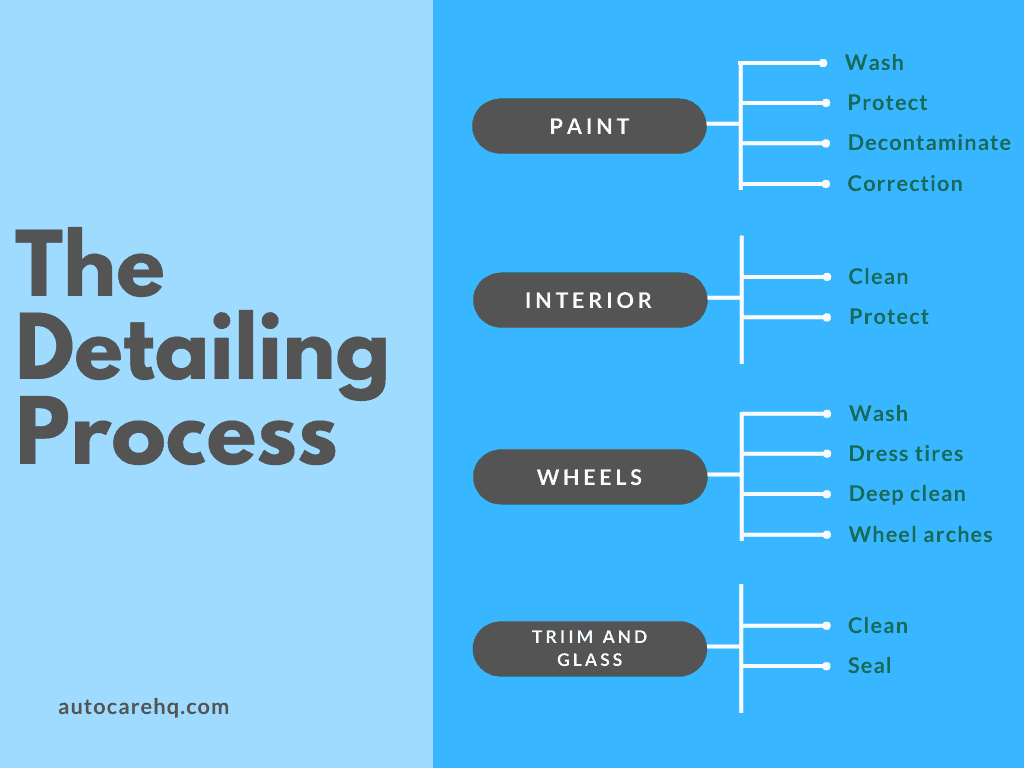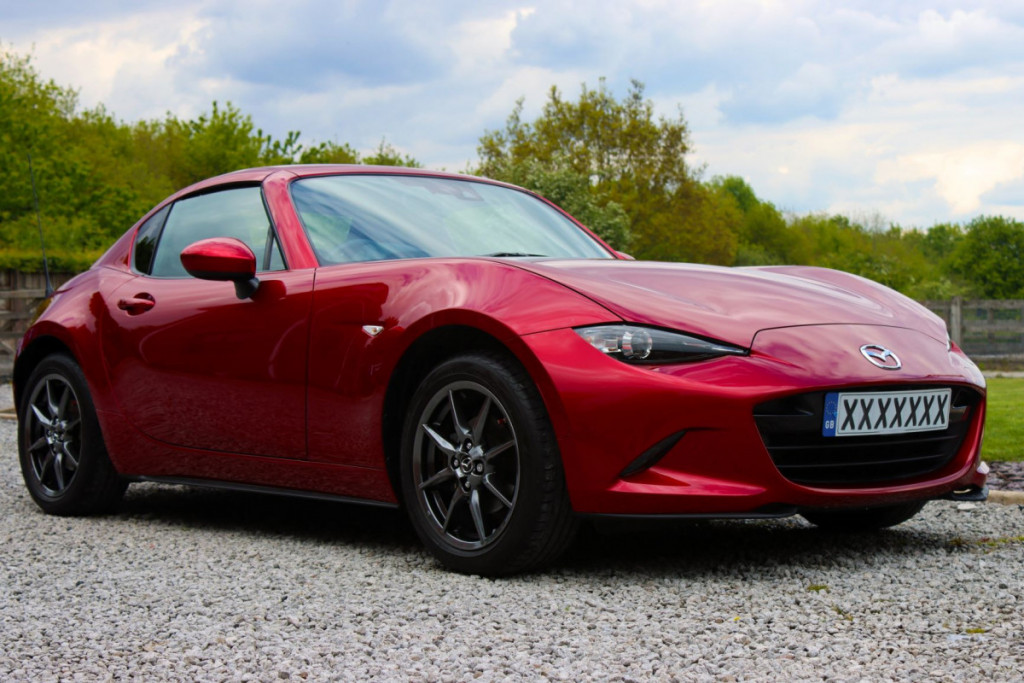If you want your car to be protected from the elements and look super shiny, then you’ll need to detail it regularly. But how often should you actually detail your car to get the best results?
In this article, I’ll be breaking it down by talking about each aspect of detailing and how often it should be done so your car stays looking fresh without wasting any more time and money than necessary. So let’s get started.
The Quick Answer
Most cars should be fully detailed every 6-12 months and then maintained with a “quick detail” at least once per month to keep the vehicle in the best possible condition.
There are many stages to detailing and areas of the car to consider. Some detailing processes can be performed less frequently and others need to be performed weekly to keep the car looking brand new.
Here’s a quick breakdown of the detailing process and how often each step should be performed.
| Detailing Process | How Often It Should Be Performed |
| Hoover and wipe interior | Weekly |
| Wash exterior | Weekly |
| Apply tire dressing | Fortnightly |
| Deep clean and protect interior | Every 3-6 months |
| Exterior decontamination | Every 6-12 months |
| Apply paint protection | Every 3-12 months |
| Apply alloy and glass sealant | Every 6-12 months |
| Paint correction (polish or compound) | Only when necessary |
What Actually is Detailing?
It’s not entirely helpful to say you should detail your car every X number of months or years, unless we break it down and understand exactly what we mean by “detailing”.
So what’s the definition of detailing? Here’s a common one.
Car detailing is the process of restoring and protecting a vehicle’s interior and exterior to keep the condition as close to new as possible.
Okay, so that’s not super helpful. But it does give us a starting point to break it down. One way, is to split it into areas of the car that need “detailing”. These are:
- Interior (glass, trim, seats, carpets, mats)
- Paintwork
- Exterior glass
- Alloys
- Tires
- Trim and plastics
- Exhaust tips
This helps, but we also need to think about the level of detailing as well.
For example, you can detail the paintwork by washing it, using a wax, sealant or coating, decontaminating it using clay, or correcting it by polishing or compounding.
All these can be considered forms of detailing, because they help to restore or protect the finish to keep it looking as new as possible.
So we need to also think about how thorough the detailing process is, as well as the area of the car.
I’ve made a flow-chart to demonstrate this. So at the top, we have the processes that take the least amount of time and should be performed more often, then at the bottom we have the processes that are more in-depth and should be performed less often or only when necessary and not part of a routine.
I’ve split each area of the car up as well to make things a bit clearer. Note: this isn’t the order that you would detail the car in, it is just to list the priority of how often these processes should be performed.

To give you a complete answer, I’m going to break down the detailing process into the following levels (from least to most in-depth), and give you a guide to how often they need to be performed.
- Quick detailing
- Decontamination and protection
- Paint correction
- Interior detail
Quick Detail
Quick detailing basically involves sprucing up the interior and exterior. It’s not designed to give a car a massive transformation, but instead to keep the vehicle maintained and protected between more in-depth details.
What Does a Quick Detail Include?
- Thorough wash of exterior glass, trim, paint and alloys
- Wipe door jambs
- Top up of paint protection using a spray wax or quick detailer spray if needed
- Application of a tire dressing
- Hoover and wipe down interior surfaces and clean the glass
Usually a quick detail will take between 1-2 hours. It’s a slight step up from a normal “car wash” because there’s some focus on the alloys, interior and paint protection top-up.
A quick detail like this should be performed at least once per month. Ideally, the car should be washed and the interior cleaned weekly, then the paint protection can be topped up with a spray wax or quick detailer spray every month depending on the existing protection.

Full Interior Detail
Next we will talk about the full interior detail. If you regularly maintain the interior, then it should already be pretty clean.
A full interior goes a step further as it’s more about deep cleaning the interior so it looks brand new and protecting it so it stays that way.
What Does a Full Interior Detail Include?
- Hoover and wipe surfaces and clean the glass
- Shampoo all carpet, mats, upholstery and the headliner
- Use a steamer to deep clean if necessary
- Clean all crevices using compressed air and fine brushes
- Clean the door jambs
- Deep clean leather and seal or condition
Optional
- Apply a dashboard dressing
- Apply fabric or leather sealant
As you can see, this is far more in-depth than the interior spruce up you get with a quick detail. As a result it usually takes around 1-2 hours, depending on the current condition of the vehicle.
A full interior detail where the car is deep cleaned and surfaces are protected or conditioned should be performed at least every 6 months. If the car is driven daily, it may be necessary to full detail the interior every 3 months to keep the vehicle looking as new. as possible
Decontamination and Protection Detail
This is the next step up of the exterior detail. Again, it goes much further than washing and topping up the protection. Instead, it involves a very deep clean and application of a longer-lasting sealant or ceramic coating to make sure the finish is properly protected.
What is Involved in an Exterior Protection Detail?
- Thorough wash of exterior glass, trim, paint, exhaust tips, alloys, wheel barrels, wheel arches and tires
- Chemical decontamination using an iron fallout remover and tar remover
- Physical decontamination using a clay bar, mitt or cloth
- Removal of old waxes, coatings or sealants
- Application of a durable sealant, wax or coating to the paintwork
- Dressing of tires and trim
- Polishing the glass
Optional
- Sealant or coating applied to the alloys
- Sealant or coating applied to the glass
A decontamination and protection package will ensure the car is thoroughly cleaned and protected to enhance the paintwork and keep the finish looking newer for longer. It will usually take around 3-4 hours to perform this kind of detail.
A full decontamination and protection detail should be performed roughly annually to ensure the car is protected and cleaned properly. Usually cars which are driven daily will need a full exterior detail every 6 months to keep them in proper condition.

Paint Correction Detail
This is the most in-depth kind of exterior detail. It will include everything we’ve already spoken about so far, but also includes an additional step, paint correction.
Paint correction involves removing a layer of the car’s clear coat to permanently remove clear coat scratches and swirl marks. This is usually performed using a dual-action polisher.

This kind of detail should not be performed as part of a routine. Instead, you should only correct the paint when absolutely necessary because you can only do it so many times before you remove all of the clear coat.
Take a look at this article I’ve written about the risks of polishing to learn more about what it does, and when to do it.
Full Paint Correction Details Include the Following:
- Thorough wash of exterior glass, trim, paint, exhaust tips, alloys, wheel barrels, wheel arches and tires
- Chemical decontamination using an iron fallout remover and tar remover
- Physical decontamination using a clay bar, mitt or cloth
- First stage of paint correction: compounding (damage removal)
- Second stage of paint correction: polishing (refinement)
- Application of a durable sealant, wax or coating to the paintwork
- Dressing of tires and trim
- Polishing the glass
Optional
- Sealant or coating applied to the alloys
- Sealant or coating applied to the glass
Paint correction details should only be performed when necessary and not part of a routine in order to preserve the car’s clear coat. To enhance the look of the vehicle, a decontamination and protection detail is more appropriate.

Summary Checklist
So those are the 4 main types of detail and how often they should be performed. Here is a quick summary of the processes we have discussed and how often they should be done.
| Exterior Detailing Process | How Often? |
| Washing of exterior surfaces | Weekly |
| Apply tire dressing | Every 1-2 weeks |
| Top up paint protection | Monthly |
| Apply trim dressing | Every 6 months |
| Decontamination | Every 6-12 months |
| Full paint protection | Every 6-12 months |
| Apply glass and alloy sealant | Every 6-12 months |
| Paint correction (polish or compound) | Only when necessary |
| Interior Detailing Process | How Often? |
| Hoover and wipe surfaces | Weekly |
| Clean crevices using brushes or compressed air | Every 3 months |
| Shampoo carpets, mats and upholstery | Every 3 months |
| Deep clean leather and seal | Every 3-6 months |
| Deep clean door jambs | Every 6 months |
| Apply dashboard dressing | Every 6 months |
| Apply a fabric sealant | Every 6 months |
How to Tell When a Car Needs Detailing
So I’ve given an estimate of how often a car needs to be detailed, but how do you actually know the time has come?
Here are a few signs to look out for to tell whether your car needs detailing:
- The finish looks dull and flat even after it has been cleaned
- The windshield is covered in smudges and water gets smeared across the glass leaving streaks
- The tires look browned and faded
- The paintwork feels rough to the touch
- Any interior odours
Frequently Asked Questions
Now we’ve been through when you should detail your car to keep it looking it’s best, I thought it’d be a good idea to run through some answers to some of the other most commonly asked questions about car detailing.
How long does it take to detail a car?
A quick detail of a car to give the interior and exterior a refresh and top up the paint protection will usually take 1-2 hours.
In-depth interior detailing which brings the interior back to new condition and protects the surfaces will take around 2 hours.
A full exterior decontamination and protection detail will take around 3-4 hours. Details involving paint correction will often take upwards of 6 hours depending on the condition of the paint.
Take a look at this article I’ve written on how long it takes to detail a car to learn more about each process and how long it realistically will take you.
Should you get a professional detail or DIY?
This is a huge question that car owners ask. There are two reasons why you may want to take your car to a professional to get it detailed.
- You don’t have the time yourself
- You don’t have the skills or confidence
I think reason #1 is perfectly valid. Detailing can take a long time and not everyone has, or wants to spend very long maintaining their vehicle. Personally, I don’t mind spending several hours on an afternoon detailing my car, but I totally get why others would mind.
However, reason #2 is a little more complicated. Most aspects of detailing don’t take a huge amount of skill, and that’s why I created this website. To give answers that car owners have about detailing so they don’t need to hire a pro.
Paint correction is the only aspect that I would consider hiring a professional to do, because it can go wrong if you don’t know what you’re doing. But again, it’s definitely possible to teach yourself safely, and it’s what I have done in the past.
I think hiring a professional detailer is an expensive option, but if you don’t have the time, or your car needs a lot of work, then it may be the right option for you.
But I definitely recommend taking the time to learn how to detail your car yourself because it’s far more cost effective, and a really enjoyable process for a lot of people.
Should you get a new car detailed?
A new car should be detailed as soon as possible to make sure it’s in the best condition possible and remains protected. Detailing a brand new car is essential if you want to keep it looking new for as long as possible.
Take a look at this article I’ve written on the 6 reasons why you should detail a brand new car to learn more about why it’s so important.
Thanks for reading! I hope you’ve enjoyed this article. Take a look around the rest of the website to learn more about making your car look its best.

